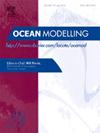Mixed layer depth parameterization and ocean surface cooling induced by tropical cyclones
IF 2.9
3区 地球科学
Q2 METEOROLOGY & ATMOSPHERIC SCIENCES
引用次数: 0
Abstract
Cooling of the ocean surface, induced by the tropical cyclone (TC), provides strong negative feedback leading to TC weakening. Parameterization of the upper ocean mixed layer (ML) depth and the sea surface temperature (SST) anomalies induced by TC is a key issue which is addressed in this paper. Using the one-dimensional heat balance equation and pre-storm vertical profiles of temperature, ML depths are estimated from SST anomalies observed by satellites in wakes of 417 TCs in different regions the World Ocean. To analyze the data, a self-similar approach is used that relates the ML depth to the ML transport and the buoyancy drop at the base of the ML. Expressing the ML wind drift transport in terms of TC parameters (maximum wind speed, translation speed and radius), the Coriolis parameter and underlying stratification, and also taking into account the influence of TC-induced upwelling, a parameterization of the ML depth is proposed, which is quite general. This parameterization combined with the heat conservation equation constitutes parameterization of the SST anomaly induced by the TC. Comparison with observations demonstrates effectiveness of the suggested parameterization in reproducing the SST anomalies in a wide range of surface cooling values (up to −10 °C) produced by TCs of different categories moving across various basins of the World Ocean with different stratification.
混合层深度参数化与热带气旋引起的海洋表面冷却
热带气旋(TC)引起的海洋表面冷却提供了强负反馈,导致TC减弱。高温对流引起的上层海洋混合层深度和海温异常的参数化是本文研究的关键问题。利用一维热平衡方程和风暴前温度垂直剖面图,利用卫星观测到的世界大洋不同地区417个tc尾迹的海温异常估计了ML深度。为了对数据进行分析,采用自相似方法,将ML深度与ML输运和ML底部浮力下降联系起来。用TC参数(最大风速、平移速度和半径)、科里奥利参数和下垫层来表示ML风漂输运,并考虑TC引起的上升流的影响,提出了ML深度的参数化,该参数化具有较好的通用性。该参数化与热守恒方程相结合,构成了由TC引起的海温异常的参数化。与观测值的比较表明,所建议的参数化方法在再现由不同类型的tc在不同分层的世界海洋不同盆地中移动所产生的大范围表面冷却值(高达- 10°C)内的海温异常方面是有效的。
本文章由计算机程序翻译,如有差异,请以英文原文为准。
求助全文
约1分钟内获得全文
求助全文
来源期刊

Ocean Modelling
地学-海洋学
CiteScore
5.50
自引率
9.40%
发文量
86
审稿时长
19.6 weeks
期刊介绍:
The main objective of Ocean Modelling is to provide rapid communication between those interested in ocean modelling, whether through direct observation, or through analytical, numerical or laboratory models, and including interactions between physical and biogeochemical or biological phenomena. Because of the intimate links between ocean and atmosphere, involvement of scientists interested in influences of either medium on the other is welcome. The journal has a wide scope and includes ocean-atmosphere interaction in various forms as well as pure ocean results. In addition to primary peer-reviewed papers, the journal provides review papers, preliminary communications, and discussions.
 求助内容:
求助内容: 应助结果提醒方式:
应助结果提醒方式:


